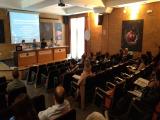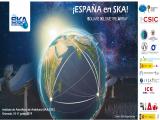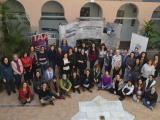Headlines and events archive
Displaying 301 - 350 of 1543
You may also find an archive of news published in the media which are related with the Instituto de Astrofísica de Andalucía - CSIC.
Pages

|
15/04/2021 - 12:30
Unveiling the low surface brightness Universe From the beginning of time, humankind has wondered what lies behind the darkness of the night sky. From the pre-telescope era to the present, our ability to see the lowest surface brightness details in the sky has improved by a factor of one million. In this talk, I describe how our vision of the sky has changed over time and how the recent developments in ultra deep imaging have speed up our capacity to discover new objects and structures in... Dr. Ignacio Trujillo |

|
04/03/2021 - 12:30
SO Webloquio: Multiple stellar populations in globular clusters: Properties, origin, open questions Globular clusters (GCs) are fascinating objects nearly as old as the Universe that provide insight on a large variety of astrophysical and cosmological processes. However, their formation and their early dynamical evolution are far from being understood. In particular, the classical paradigm describing GCs as large systems of coeval stars formed out of chemically homogeneous material has been definitively swept away by recent high-precision... Dr. Corinne Charbonnel |

|
18/12/2020 - 12:30
SO Webloquia: ESO: supporting European leadership in ground-based astronomy ESO is de facto the lead world-wide organisation in building and operating most powerful ground-based astronomical observatories. The success of the organisation relies on the support of its member states and the cooperation with the community, among other key factors. Over 1000 refereed papers are published every year using data from ESO facilities, with an increasingly larger fraction of these data coming from the archive. Among these... Prof. Xavier Barcons |

|
18/03/2021 - 12:30
SO Webloquio: Polarimetry in the planetary sciences The past few decades have been characterized by the rapid development of astronomical polarimetry that has resulted from new polarimetric instrumentation, new techniques and new theories. Such advances have aided the exploitation of polarimetry in areas ranging from solar system bodies to exoplanets and allowed the development of completely new fields of polarimetric exploration such as cometary nuclei, transneptunian objects, protoplanetary and... Dr. Ricardo Gil-Hutton |

|
18/02/2021 - 12:30
SO Web-Colloquia: The Search for Advanced Extraterrestrial Civilisations via Anomalies in Astronomical Survey Data Energy-intensive civilisations are likely to have a significant impact on both their local and extended environments – we already see evidence for this here on Earth. Advanced technical civilisations may reveal themselves to other civilisations by introducing anomalous signals into astronomical data. Artificial radio signals are perhaps the best known example but there are also many other possibilities e.g. excess infra-red emission due to waste... Dr. Mike Garrett |

|
11/02/2021 - 12:30
SO Web-Colloquia: The influence of the star-forming environment on planetary systems Planet formation occurs at the same time as star formation, and so the environments in which stars are born are also the birthplaces of planetary systems. Star forming regions are very dense, meaning that encounters between stars and planetary systems are common. Furthermore, the intense UV radiations fields from intermediate and massive stars can truncate, or destroy protoplanetary discs. In this talk, I will describe the detrimental effects of... Dr. Richard Parker |

|
04/02/2021 - 12:30
PHANGS-Halpha : A narrow-band survey of nearby star-forming galaxies observed with ALMA This work collects a representative sample of star-forming galaxies as part of a major effort the Physics at High Angular resolution in Nearby GalaxieS (PHANGS) collaboration has been making to build surveys with matched cloud-scale resolutions. Observations resolved at 50–150 pc are necessary to isolate individual Giant Molecular Clouds (GMCs) and HII regions to probe different phases of star formation from cold gas to stellar clusters. In this... Dr. Alessandro Razza |

|
25/03/2021 - 12:30
SO Webloquio: Searching for the formation mechanisms of brown dwarfs New generation of Submillimeter facilities in the North of Chile, like the APEX antenna and the Atacama Large Millimeter/submillimeter Array (ALMA), offers for the first time the possibility for studying the formation of stars, brown dwarfs, and planets with unprecedented sensitivity and angular resolution in the millimeter/submillimeter regime. The formation of Brown Dwarfs (BDs) is a debated topic of research. The most widely discussed... Dr. Itziar de Gregorio Monsalvo |

|
21/01/2021 - 12:30
SO Web-Colloquia: Osiris-Rex: results on a mission to understand planetary systems In September 2016, the NASA OSIRIS-REx spacecraft was successfully launched from Cape Canaveral Air Force Station, in Florida. That was the beginning of an amazing journey to reach near-Earth asteroid Bennu, collect a sample of material from its surface, and bring it back to Earth in 2023. The so-called “Touch-And-Go” maneuver or TAG, took place on October 20, 2020 and the sample collector head has been safely placed into the Sample Return... Dra. Julia de León |

|
12/01/2021 - 12:30
SO Web-Colloquia: Primordial black holes, gravitational waves and dark matter More than twenty years ago, we predicted that massive primordial black holes (PBH) would form via the gravitational collapse of radiation and matter associated with high peaks in the spectrum of curvature fluctuations, and that they could constitute all of the dark matter (DM) today. In 2015, we predicted the clustering and broad mass distribution of PBH, which peaks at several Msun, and whose high-mass tails could be responsible for the seeds... Dr. Juan García-Bellido |

|
17/12/2020 - 12:30
SO Web-Colloquia: On the formation of stellar clusters In this presentation, I will show how the analysis of the spatial distribution of young stars (YSO) and its comparison to the core population can reveal stellar formation episodes in star forming regions, and help us understand the fragmentation process. I will focus in particular on two very different regions: the relatively massive cluster NGC2264 and the Taurus association. Our recent study of the clump and YSO populations in NGC 2264... Dra. Estelle Moraux |

|
10/12/2020 - 12:30
SO Web-Colloquia: Stellar population gradients and kinematics of ETGs as revealed by MaNGA In this talk I will summarise the findings presented in a series of four papers dedicated to the study of early type galaxies (ETGs) with integral field spectroscopy (IFU) from the MaNGA survey. The formation channels and mass assembly of ETGs is still a matter of debate in current galaxy evolution models. The combined analysis of galaxy kinematics and stellar population gradients (age, metallicity, alpha-enhancement, initial mass function -IMF... Dra. Helena Domínguez Sánchez |

|
25/02/2021 - 12:30
SO Web-Colloquia: The exoplanet revolution The wealth and diversity of planetary systems that have now been detected modified our perspective on planet formation as a whole and more specifically our place in the Univers. It also present an opportunity of historical perspectives and an irresistible call to look for signs of life on these new worlds as a way to explore our own origins. I will introduce the audience with the challenges and recent progresses in this new field of research and... Dr Didier Queloz |

|
14/01/2021 - 18:00
SO Web-Colloquia: The Blanco DECam Bulge Survey The Blanco Dark Energy Camera (DECam) Bulge survey is a Vera Rubin Observatory (LSST) pathfinder imaging survey, spanning ∼ 200 sq. deg. of the Southern Galactic bulge, −2◦ Dr. Michael Rich |

|
03/12/2020 - 12:30
From direct imaging to gravitational waves: tracing the life of gas giant exoplanets In two decades, the field of exoplanet science has undergone nothing short of a revolution. With such a variety of planetary systems detected, the next step in exoplanet research is to characterise the properties of these systems. In this talk I will focus on “life and adventures” of gas giant exoplanets, and present how future space missions such as JWST, ARIEL and LISA will help us understand the nature, formation and evolutionary history of... Dr. Camilla Danielski |

|
28/01/2021 - 18:00
SO Web-Colloquia: Vera C. Rubin Observatory: A Big Data Machine for the 21st Century Vera C. Rubin Observatory and its Legacy Survey of Space and Time (LSST) boasts an 8.4-m diameter mirror, a camera the size of a bus, and a 3.2-gigapixel detector. It will image the entire southern sky from Chile every few nights beginning in 2023, and enable astrophysics on all scales, from near-Earth asteroids to cosmic acceleration. With nightly data volumes around 20 TB and a final data release of 15 PB, LSST is ushering in a new paradigm... Dr. Meredith Rawls |

|
18/01/2021 - 29/01/2021
Planets, exoplanets and their systems in a broad and multidisciplinary context Granada |

|
29/10/2020 - 17:00
Our Galactic Center: A Unique Laboratory for the Physics & Astrophysics of Black Holes The proximity of our Galaxy's center presents a unique opportunity to study a galactic nucleus with orders of magnitude higher spatial resolution than can be brought to bear on any other galaxy. After more than a decade of diffraction-limited imaging on large ground-based telescopes, the case for a supermassive black hole at the Galactic center has gone from a possibility to a certainty, thanks to measurements of individual stellar orbits. The... Dr. Andrea Ghez |

|
12/11/2020 - 12:30
SO web.Colloquio: GRAVITY+, all Sky, High Contrast, Milli-Arcsecond Optical Interferometric Imaging and Spectroscopy GRAVITY and the VLTI have transformed high angular resolution astronomy with groundbreaking results on the Galactic Center, active galactic nuclei, and exoplanets. The GRAVITY+ project will soon boost optical interferometry to the next level, opening up the extragalactic sky for milli-arcsecond resolution interferometric imaging, giving access to targets as faint as K = 22 mag, and providing ever higher contrast for the observation of... Dr. Frank Eisenhauer |

|
23/11/2020 - 27/11/2020
SOMACHINE Machine Learning, Big Data, and Deep Learning in Astronomy Granada |

|
16/09/2020 - 17/09/2020
Scientific writing and presentation in Astronomy |

|
22/10/2020 - 12:30
We’ve never imaged the Sun’s surface from that close. Solar Orbiter will change that In February 10, 2020, Solar Orbiter, the new ESA's Sun-exploring mission built in collaboration with NASA, was successfully launched atop an ULA Atlas 5 rocket from Cape Canaveral in Florida. Equipped with ten instruments, six for remote sensing and four for in-situ measurements of the solar heliospheric conditions, it will get as close as 0.28 astronomical units (or 42 million kilometres) to the Sun in a mission that can last more than ten... Dr. David Orozco |

|
24/09/2020 - 12:30
The power of low activity black holes It is possible that most galaxies host a black hole at the centre, most of the time this being in a relatively quiescent state. The so-called low luminosity Active Galactic Nuclei are characteristic of this phase. These objects represent the vast majority of the active galactic nuclei (AGN) population in the near universe, and still the least conforming class with the standard AGN scenario. Their low luminosity is at odds with their often... Dr. Almudena Prieto |

|
19/11/2020 - 12:30
SO Web-Colloquia: Flaring on the Sun at all scales The Sun shows activity across a wide range of size and energy scales. We shall take a journey from the smallest scale events to the largest energy releases in the solar system. The energy release is due to the magnetic fields on the Sun and how they interact. Using EUV/UV spectroscopy different layers of the solar atmosphere can be probed in order to understand the physical processes that occur. The EUV imaging spectrometer onboard the Hinode... Dr. Louise Harra |

|
15/10/2020 - 12:30
So Web-Colloquia: The star formation process on cloud-scales in nearby galaxies Where do stars form and how is their formation regulated across galactic disks are two critical questions for our understanding of the star formation process. High angular observations of nearby galaxies allow us to sample the star formation process across entire galactic disks reaching now regularly the scales of the star-forming units, namely Giant Molecular Clouds (GMCs) and HII regions. Such data provide new insights on the molecular gas... Dr Eva Schinnerer |

|
08/10/2020 - 12:30
SO Web-Colloquia: Recent findings on nova explosions Nova events are the result of the interaction of low-mass binary systems. A compact white dwarf (WD) accretes material from an old and cold companion until a thermonuclear runaway takes place on its surface. Such explosive events can be considered the scaled-down siblings of supernova (SN) explosions, but its study has many advantages over SNe, as nova events are more numerous (some systems even exhibit recurrent explosions within decades) and... Dr. Toalá Sanz |

|
01/10/2020 - 12:30
SO Web-Colloquia: Following black hole evolution from z=5: mergers and outflows The growth and evolution of the most massive black holes, and their host galaxies, can be followed from z=7 and even earlier. The critical events that shape this evolution are major mergers, Eddington or super-Eddington accretion, violent star formation, and powerful outflows. I will present the results of a systematic study of 40 AGN at z~4.8 using Gemini, VLT, Herschel and ALMA. Our recent (2019) ALMA data allow a fresh look at major mergers... Dr. Hagai Netzer |

|
08/07/2021 - 12:30
SO Colloquium: TeV Halos and their connection to the Leptonic Cosmic Ray flux measured at the Earth The origin and propagation of cosmic rays (CRs) is one of the most important questions in astroparticle physics nowadays. CRs generated by known sources also serve as background to those putatively generated by more exotic phenomena such as dark matter. Apart from the known electrons of primary origin and positrons of secondary one, pulsars and sources powered by them are one of the main candidates to contribute to the total amount of CR... Dr. Rubén López-Coto |

|
25/06/2020 - 24/07/2020
Course on gender analysis in research |

|
20/11/2019 - 21/11/2019
III Course on Scientific Dissemination Techniques Granada |

|
18/11/2019 - 22/11/2019
Tenth Gammapy Coding Sprint Granada |

|
01/07/2020 - 17/07/2020
Introductory course to astronomy and astrophysics Granada |

|
25/02/2020 - 29/02/2020
Open Science Droplets Granada |

|
11/11/2019 - 15/11/2019
SUNRISE III Technical Meeting Granada |

|
14/11/2019 - 15/11/2019
9th ACS Science Team Meeting Granada |

|
02/12/2019 - 03/12/2019
Comet Interceptor Full Team Meeting Granada |

|
04/11/2019 - 08/11/2019
1st IAA-CSIC Severo Ochoa School on Statistics, Data Mining and Machine Learning Granada |

|
23/04/2019 - 23/04/2019
Seminar on Preparation of Proposals to the European Research Council (ERC) Granada |

|
13/06/2019 - 13/06/2019
Key Aspects in the Preparation of a Competitive Proposal MSCA-IF Granada |

|
10/06/2019 - 11/06/2019
¡España en SKA! Granada |

|
05/11/2020 - 12:30
SO Web-Coloquia: The Arecibo Observatory Roadmap for the Future: science enhancement plans under UCF management The Arecibo Observatory (AO) has supported cutting-edge research in the fields of Astronomy, Planetary Science, and Space Atmospheric Science for decades. The unprecedented sensitivity of the Arecibo antenna has led to fundamental contributions in a wide variety of research programs, including the first detection of an exoplanet around pulsar (Wolszczan... Dr. Noemi Pinilla-Alonso |

|
04/05/2021 - 12:30
SO Web-Colloquia: Thematic area 9 of the CSIC’s new White Book: Understanding the basic components of the Universe, its structure and evolution CSIC is about to publish a White Book to define its scientific strategy for the coming decades. The White Book contains chapters on 14 different thematic areas. One of the main goals of this exercise is to increase collaboration between research groups and institutes of the CSIC. Particular value is set on inter- and cross-disciplinary work. Each thematic area defines a set of “challenges”, key scientific questions for the coming decade(s) in... Dr. María José Costa and Dr. Rainer Schödel |

|
17/09/2020 - 12:30
SO Web-Colloquia: J-PAS: First light results of the JPCam The Javalambre-Physics of the Acclerating Universe Asptrohysical Survey (J-PAS) have just started to scan thousands of square degrees of the northern sky with 56 narrow band filters and the JPCam instrument with the telescope 2.5m of the Javalambre Observatory. Before the JPCam started its operation, we have observed with the pathfinder camera one sq. deg on the AEGIS field (along the extended Groth Strip). This colloquium will present the... Dr. Silvia Bonoli |

|
28/05/2020 - 12:30
Galaxy clusters and their environment Clusters of galaxies are located at the intersection of cosmic filaments. I will first describe how we have found large extensions around clusters, at optical and/or X-ray wavelengths, suggesting that we are indeed detecting the cosmic web around clusters, and I will discuss some galaxy properties in one of these extended filaments. At the cluster scale, I will then describe our searches for substructures in X-rays and show how X-ray... Dr. Florence Durret |

|
31/03/2020 - 12:30
HI mapping of nearby dwarf galaxies with SKA pathfinders: unique capabilities of KAT-7 and MeerKAT Dwarf galaxies are by far the most numerous galaxies in the Local Universe. Their simple structure and proximity provides a unique window to the detailed investigation of various processes necessary for galaxy formation and evolution. One of the most reliable approach for studying the evolution of galaxies is to look at their physical properties using the neutral hydrogen gas (HI). In this talk I will present ongoing work on the HI properties... Dr. Brenda Namumba |

|
05/05/2020 - 05/05/2020
Workshop MAAT@GTC Granada -- Virtual Format |

|
17/03/2020 - 12:30
Magnetic fields, rotation, and activity in M dwarf stars M dwarfs are known to generate the strongest magnetic fields among main-sequence stars with convective envelopes, but we are still lacking a consistent picture of the link between the magnetic fields and underlying dynamo mechanisms, rotation, and activity. For instance, models predict that the maximum magnetic flux a star can generate scales with convective energy stored in its envelope, but no accurate measurements existed until recently.... Dr. Denis Shulyak |

|
03/09/2020 - 12:30
SO Web-loquio: Active Galactic Nuclei: fueling and feedback Dynamical mechanisms are essential to exchange angular momentum in galaxies, drive the gas to the center, and fuel the central super-massive black holes. While at 100pc scale, the gas is sometimes stalled in nuclear rings, recent observations reaching 10pc scale, or 60mas with ALMA, have revealed, within the sphere of influence of the black hole, smoking gun evidence of fueling. Observations of AGN feedback will be described, together with the... Dr. Françoise Combes |

|
10/02/2020
International Day of Women and Girls in Science The Institute of Astrophysics of Andalusia joins the celebration of the International Day of Women and Girls in Science, which seeks to make visible the scientific work of women and promote vocations in girls |
